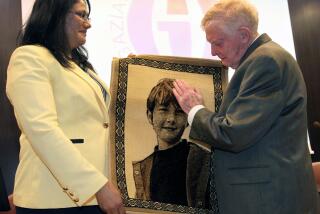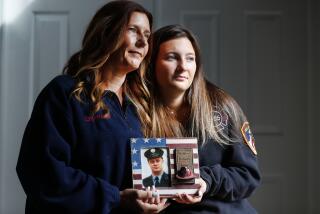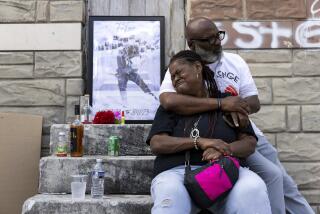Survivors put names, faces to Baltimore’s homicide victims
- Share via
Reporting from Baltimore — “My son was murdered.”
That’s how the mothers and the fathers begin their sentences.
They’ve lost loved ones to the violent streets of Baltimore -- just weeks ago, or maybe years ago -- and they want to talk. Need to talk.
They seek out a reporter.
“Do you want to talk to me about my son?”
They’re wearing T-shirts with photos of their lost children on the front.
They’re holding pictures above their heads for all to see.
They’re clutching white angels to put on a tree in a room at the downtown courthouse.
At the annual Christmas party for Survivors Against Violence Everywhere, a program sponsored by the Baltimore state’s attorney’s office to help people grieve, there aren’t enough chairs.
“It seems we’ve outgrown our space,” says the city’s top prosecutor, Patricia C. Jessamy. She adds: “It’s a sad thing.”
She urges them to remember their sons and daughters in happy times; never to forget, but also to move on, to celebrate holidays, to do something for themselves.
Murder is such a hard word to say.
Ellen Bentley lost her 19-year-old son, Donald, on Aug. 11, 1989. A student at Morehouse College, he was shot in the back as he fled a robber.
Bentley had to admit that her son was murdered -- to say the word -- so she could accept what happened.
“It took forever,” she says.
A therapist got it out of her.
“She kept after me: ‘You got to say it, you got to say it.’ It ripped my heart out.”
Bentley is still waiting for police to make an arrest.
So is Jessie Snead.
Her son, Terrance Thompson, was shot in a row house in 1993.
He was found lying on the pavement after he tried to crawl home. He died at a nearby hospital. He was 26.
This year, 225 had fallen to homicide as of Dec. 16. Last year, it was 234, a 20-year low, police say. In the 1990s, the city had 10 consecutive years with 300 or more victims. Snead’s son was shot in Baltimore’s most murderous year on record; 353 were killed.
The number of people slain in Baltimore since 1970: 10,591.
The families decorating the Angel Tree of Remembrance are tired of the numbers. This party, Snead says, “is a reminder that each one of those numbers belongs to someone.”
As she reads the names aloud, the mothers and fathers and brothers and sisters and grandmothers and children hang an angel on the tree.
Each one represents a victim -- a person.
Snead calls out 61 names.
“And there are more every year,” she said.
More to Read
Sign up for Essential California
The most important California stories and recommendations in your inbox every morning.
You may occasionally receive promotional content from the Los Angeles Times.










